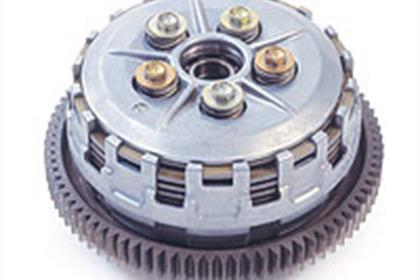Why you shouldn’t ignore your clutch
The clutch, bless it, is a bit like an old aunt who comes round for a family gathering. You know it’s there, but after a while you just ignore it. Often it’s not mentioned at all in the specification section of new bike brochures.
The need for a clutch, unlike an old aunt, is simple. Petrol engines don’t produce high power at low revs, so they have to be spinning fast before there is sufficient power to apply to the wheel. The clutch is a means of feeding that power in smoothly and progressively. You also need a clutch to disengage the engine from the transmission to change gear while you’re on the move.
To understand how a conventional friction clutch works, imagine two discs, or plates, one fixed to the engine, the other to the transmission. When they’re apart, there’s no contact between the engine and the transmission, so the wheel doesn’t turn. If they’re brought together, the friction between the surfaces allows drive to be transmitted. The extent of the drive is governed by the degree of force pushing the discs together. If the force is reduced, slip occurs. If it is increased, the drive transmitted increases proportionally.
There are two types of motorcycle clutches: Wet and dry. Both normally have several plates, though some early BMW twins used a single-plate clutch similar to that normally found in a car. The advantage of multiple plates is that a massive surface area can be provided for the transmission of power, without taking up much more space. A typical sports bike, for example Suzuki’s GSX-R750, has 19 of them – 10 made out of heavy-duty cork, plus nine driven plates made out of metal.
Both wet and dry types work on the same principle, and they can be operated either hydraulically, or mechanically by means of a cable. Both have advantages and disadvantages…
WET CLUTCH
With a wet clutch the engine/transmission oil flows into the clutch housing, immersing and lubricating the plates. Most modern road bikes use a wet clutch. One advantage is that they are generally smoother because fierce clutch engagement is damped down by the lubricant. The presence of the lubricant also means wet clutches tend to run cooler, are more durable and are also quieter.
The disadvantage of the wet system is the possibility of a small power loss due to resistance created by the lubricant – though this is unlikely to have much of an impact on road bikes. A wet clutch is also at the mercy of the engine oil used. Many synthetic superbike oils are simply fully synthetic car oils with a different label on the bottle. These oils contain ” friction modifiers ” , which aren’t a problem in the engine, but can eventually build up on the clutch and cause temporary total loss of drive.
DRY CLUTCH
The dry clutch, as the name suggests, runs dry in its own chamber isolated from the engine/transmission oil. It has the advantage of being more direct, it minimises transmission power losses and it is capable of handling more power than an equivalent wet clutch the same size. Dry clutches are therefore commonly used in race bikes. However, some road bikes also use the dry system, notably Ducati and BMW.
One disadvantage of the dry clutch is that it wears out faster than a wet clutch. It also tends to be a lot noisier.
So what causes a clutch to wear out? In most cases, the rider! Poor clutch control, such as using too many revs while slipping the clutch to pull away, wears the components rapidly and leads to premature failure.
Worn clutches slip, causing the engine revs to suddenly rise at a given speed. The problem usually occurs when the bike is under load, such as when it’s pulling away or going uphill. A worn clutch can also drag. This is when the plates don’t disengage fully, resulting in a ” clunk ” when you change gear.
Properly treated, though, a bike’s clutch will be very reliable and should last a long time. If it has been abused or has worn due to high mileages, the solution is to either replace the whole unit or replace individual components such as plates or springs. Often original parts are used, though you can get aftermarket plates from firms like EBC, either cork ones like the originals or stronger Kevlar-lined versions. Stronger springs are also available to help prevent slip. High-tech carbon-fibre clutches made by AP Racing are beginning to appear in top race machines, and are bound to become more popular in future as they are lighter as well as stronger than the original parts.
The cost of sorting a knackered clutch varies according to which components need replacing. Swopping the whole assembly is likely to cost you in the region of £500 – plenty of reason to develop good clutch control!


